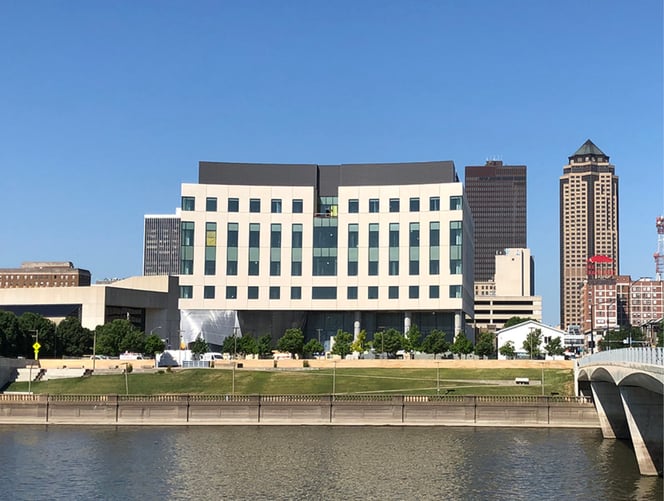What is the USGBC’s Sustainable SITES Initiative?

Adopting a building certification system is one of the most effective ways to reduce your project’s environmental impact. There are many certification systems on the market, including Leadership in Energy and Environmental Design (LEED), WELL, and Living Building Challenge (LBC).
While these certification systems mainly focus on the building itself, it’s also important to consider your building site, its water usage, and its impact on wildlife. The Sustainable SITES Initiative addresses these concerns by providing a framework for sustainable landscape development.
Although landscape architects normally oversee SITES certification, we have collaborated on projects that utilized the certification system, including the Des Moines Federal Courthouse. Here, we’ll discuss SITES in more detail and explain the types of projects it best fits, helping you determine if it aligns with your goals.
Understanding the Sustainable SITES Initiative
The Sustainable SITES Initiative began with a partnership between the American Society of Landscape Architects (ASLA), the Lady Bird Johnson Wildlife Center at the University of Austin, and the United States Botanical Garden. Today, it is overseen by the US Green Building Council (USGBC).
The program is a culmination of years of research into soil, vegetation, building materials, and human health. It seeks to preserve landscapes and regenerate degraded ones by focusing on seven areas of landscape design:
- Water demand
- Storm water runoff
- Wildlife habitats
- Energy consumption
- Air quality
- Human health
- Outdoor recreation opportunities
Like LEED and WELL, SITES sets performance measures rather than prescriptive practices. This flexibility allows designers to adapt to local climates and generate creative solutions.
SITES is a point-based system, and depending on the number of points achieved, projects can earn one of four certifications:
- Certified
- Silver
- Gold
- Platinum
In short, SITES provides a comprehensive framework for developing and maintaining sustainable landscapes.

The Des Moines Federal Court House, a SITES project.
SITES vs. LEED
Both SITES and LEED are overseen by the USGBC. Although LEED includes site-related measures, SITES goes deeper and offers a more comprehensive approach to landscape design.
The difference between the two programs boils down to their focus. While LEED mainly focuses on building design and construction, SITES focuses on landscape design and maintenance.
Since the two programs have different focus areas, they can be used separately or in tandem.
General Services Administration (GSA) projects, for example, utilize both programs.
If you pursue SITES, you may need to work with a landscape architect. Your building architect can provide recommendations and help you with your search.
Project Types that Align with SITES
Pursuing a SITES certification can offer many benefits. Its prescriptive practices can reduce your building site’s water demand, filter storm water, protect wildlife habitats, improve air quality, and create outdoor recreation opportunities for your building’s occupants. Together, these benefits can lead to improved occupant health and energy savings.
The program fits most projects. After all, every building project has a site. However, some projects may be more well-suited for SITES than others.
Projects with large landscaping components, like corporate campuses or public recreation areas, align well with the program. It also aligns well with building projects that may not fit more building-focused certification systems like LEED or LBC. For example, SITES may fit building projects like park pavilions.
Learn More About Building Project Certification Systems
The most successful building projects consider all aspects of sustainability, including energy consumption, human health, and wildlife impact. While most certification systems focus on building design, the Sustainable SITES Initiative fills a gap in the marketplace and provides a framework for sustainable landscape development.
The certification system helps you reduce water demand, improve air quality, improve wildlife habits, and more. Using it in conjunction with other certification systems—notably LEED—creates a more holistic approach to sustainability.
Although SITES is the only certification system to focus exclusively on landscape design, others include site requirements. The most rigorous certification system, the Living Building Challenge, sets requirements related to site selection, urban agriculture, and more. Learn more by reading about the LBC’s seven petals.